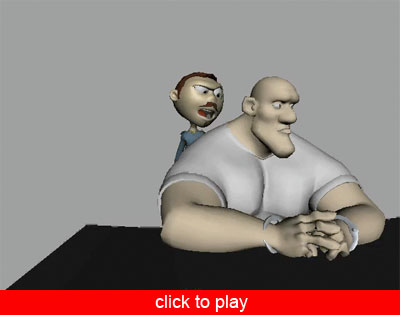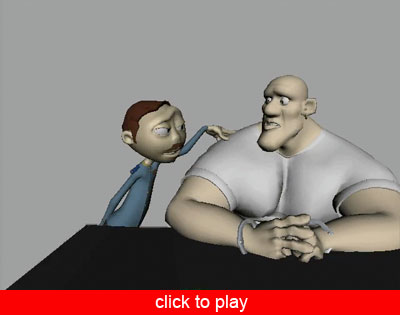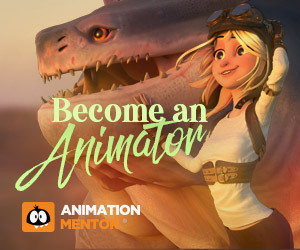Tony Travieso
Interview conducted by Eric Scheur
I was very excited when the audio choice for the 11 Second Club's August competition was a non-English clip. As animators, there is always a possibility that we will be asked to animate in a language that we don't speak; I work at a commercial animation studio, and I have been asked to animate characters speaking German ands Korean, neither of which are languages I understand. Although I had literal translations of what the characters in these jobs were saying, I felt a certain liberation in my acting choices as well as being more determined to make sure the characters' gestures were appropriate for the scene.
Consider, also, that a healthy number of the 11 Second Club's members do not speak English as their first language, and have been animating in their non-native tongue since the club began. I enjoyed watching the Work In Progress forums to see how non-Spanish speakers approached the clip, as well as how native Spanish speakers performed a clip they clearly felt a larger kinship with.
The winner of August's competition, Tony Travieso, was born and raised in New York City to a part Dominican, part Puerto Rican family. He is fluent in both English and Spanish, but like most of the great entries I watched, the language was far incidental to the characters in the animation. Both of the characters in Tony's entry have clear personalities, and his story would shine through whether the language was Spanish, English, Urdu, or even if there were no sound at all.
Congratulations to Tony on his winning animation. Tony shared with me some of his insights into the getting the detail and personality into his two characters. I especially like his inspiration for the military character, which just goes to show that inspiration can be right in front of us if we learn to recognize it. Often, the best animation ideas will come right out of our own lives. Read on!
-Eric
You are the 11 Second Club's third winner who is also an AnimationMentor graduate. What sort of animation experience did you have before AM, and what prompted your decision to enroll in the school?
I didn't have much experience before AnimationMentor. I was in a one year 3d animation course before AM, but it was more of a general course. We learned some animation, but not much. After I was done there, I looked around for different schools. There were two schools that I had my eyes on: The School of Visual Arts and AnimationMentor. I knew in my heart that animation is what I wanted to do so I went to AM. And it was one of the best choices I have made.
Talk about what you've learned since entering the industry as a professional.
One of the things I learned is to adjust my workflow to fit the company's needs. In some places you get more time to finish your shots and in other places you don't. So I had to find ways to make changes in the way I work to get my shots done on time.One of the things I struggle with most is my polish. And maybe I'm still working on it, but I have a better understanding now then I did before. With the help of my awesome mentors I now spend a lot more time in my blocking before I ever start to go into polish. They helped me understand if I do a great job in my blocking, if I take the time to make sure that Maya has enough information to do what I want her to do, then I should have an easier time in my polish stage.
Where do you find inspiration as an artist?
Like most I find my inspiration from great movies like The Incredibles, Kung Fu Panda, and Horton Hears A Who. One of things I love the most is comic book artists, like Joe Madureira and J. Scott Campbell. They spend so much time on just one pose that gives you all you need to know about that character.
Just for fun, tell me a favorite joke. :)
I really don't know many, but I do like these Chuck Norris jokes:
Chuck Norris doesn't check the time - he decides it.
When the Boogeyman goes to sleep every night he checks his closet for Chuck Norris
Some people wear Superman pajamas.
Superman wears Chuck Norris pajamas.
The August competition was our first to include a non-English audio clip. Did you find you approached this clip in a different way than you would approach an English track?
This is the first time I have animated a non-English audio clip, but my approach was the same. I broke the clip down phonetically and went from there.
Talk about the backstory in your piece. Where did it come from?
I didn't have much of a back story for this piece. When I was thinking about my idea I didn't spend too much time thinking of what or why Ace was in handcuffs. I just thought in my head, he committed some kind of crime and he was trying to get out of it. And because he's a criminal I wanted to put him in handcuffs. I just wanted to keep it simple, no crazy story, no big sets just a nice simple idea.
Talk about your animation process.
I listen to the dialogue as many times as I need to. Going and coming from work, at home just so I can fully understand every word. I come up with my ideas while I'm listening to the dialogue.
After that I run my ideas by some friends so they can help me come up with something better.
Next I write the dialogue and then break it down phonetically. I didn't use much reference for this shot. I use reference if I have a very difficult body mechanics shot or if it's something new that I have never animated before. At this point I start to draw out my thumbnails just to get my ideas down on paper. The drawings are not in detail and mostly are just key poses. I also like to make notes on my thumbnails of my ideas.
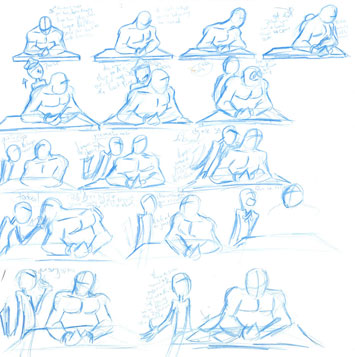
After that, I draw some of the more important poses for my characters. A little bit more detail than my thumbnails, but not much. I just like to see how the poses will work in 2D.
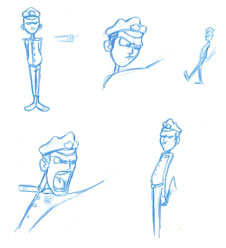
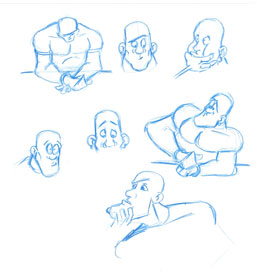
After I feel comfortable with my planning, it's time to go into Maya. I start to block out my shot with mostly just the key poses for both characters. I also rough in some of the lip sync as well.
Next I go and add more detail into my blocking one character at a time. Adding the breakdowns and also taking the lip sync further. And also my ideas start to change. Just because I planned it one way in my thumbnails doesn't mean it's set in stone.
After a few more passes of blocking it's time for me show my friends what I have so far. I listen to the feedback and make the changes I need to. Before I decided to take this shot into polish I wanted to change what I had in the beginning--for the big guy to do what you see in the final shot. Now I was happy if the shot and it was time for polish.
My polishing is pretty simple; I just go through my shot 40 to 50 frames at a time and clean it up. I get it to a certain point where the shot looks pretty good, then I leave the shot alone for a little while. Then I come back to it and make a long list of things that that I want to fix. I didn't get through the whole list before I had to upload the shot, but I was pretty happy with the way it turned out.
You make great use of one of my favorite little animation "tricks": curve reversals. You clearly put a lot of thought into them, and pushed some of the officer's line of action really far. What is your approach to getting these kinds of shapes in your animation?
I like to think of those things when I'm actually working on the shot. I allow my creative side to take over and let the ideas flow out of me. I may put some of those ideas into my thumbnails, but just in the key poses. And the dialogue helps with those ideas.
For example, if at some point in the dialogue the character is afraid or scared. I may want to move him back and give him a Reverse C shape in the body. Then if the dialogue changes to something more aggressive or angry I can change the curve to a C shape and move him forward. It's not as simple as that, but I hope you get the idea.
I also notice that you take the opportunity to have several slower moves and several faster moves in this piece (it reminds me of Victor Navone's "3 speeds" blog post). Is this something you're very conscious of when you animate?
Yes very much, this is also one of those things I like to think of when I'm working on my shots. I have a clear view in my head of how the shot is going to play out. I just like to allow myself to be creative when I think about those things. And in a dialogue shot it's a little easier to do.
With dialogue you get the highs and lows of the shot. If the dialogue starts off in a low tone, I really don't want the character to be moving super fast or have him doing really big gesture, but I do think of ways to break up the speeds in the body. It's like with music: if the beat is always the same it gets boring. So I find creative ways in changing the speed throughout the shot to make it more appealing for the audience.
You mentioned that you often get help by showing your work in progress to your friends. What were your friends' reactions and advice when you were working on this shot?
When I first started to think about the shot I had a few ideas in my head. So one day at work with two of my friends, Sean and Zack, we brainstormed for about 20 minutes. I told them about my thoughts for the shot. And they helped me come up with the scene I have now. I just didn't want to go with the first thoughts that popped into my head. So they helped me take my ideas to the next level.
What was one of the most challenging things about this particular piece?
One of the most challenging things for me was trying to get the feel of the main character across. I still feel that I didn't do a good job. The dialogue was in Spanish so I wanted the character to feel like he was from a different culture. I thought of my grandfather while I was working on this shot. He was in the military back in the Dominican Republic. He had this way of talking where his bottom jaw comes out a bit. And he always likes to walk with his hands behind his back. Always very confident with his chest out and his head held high. And when he talked everyone listened to him. So I wanted to get some of that into my character. Maybe with some more experience I will learn how to do a better job with that.
What was your initial reaction to the eCritique?
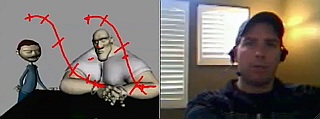
It was awesome! You would think that I would be used to these eCritiques. And then I remember how great they are and how much I miss them. In the eCritique there's a part with the big guy where Sean talks about the shoulders. That really helped a great deal. There was something bothering me about Ace, and I think that was it. It's going to help him look so much better. Also there was a part with the main character where he talked about the eyes. It was awesome to know that Sean likes to leave his eyes in stepped mode because it's something I like to do. He quickly went over how he likes to do his eye darts to help me improve my shot.
Talk about any new concepts you were introduced to (or re-introduced to) through the eCritique.
There was a 2D term that he used to name the problem that I was having with the shoulders for Ace. He called it "boiling," I never hear that term before this eCritique. I thought that was really cool.
Do you intend to return to this piece to incorporate the suggestions made in the eCritique?
I am definitely going back to this piece. I want to give it the love and attention it needs, because I think it can be a strong piece for my demo reel.
What advice would you offer to a beginner who wants to enter the competition?
If you're new to this animation thing I would take my time. I don't think you should jump right into acting shots. Learn the fundamentals of animation. Get your body mechanics down. It's hard enough understand acting and making great acting choices without having to struggle with your body mechanics or the principle of animation. If you love animation it all will come in time.
- Tony Travieso
Discuss this interview in the forums
comments powered by Disqus






